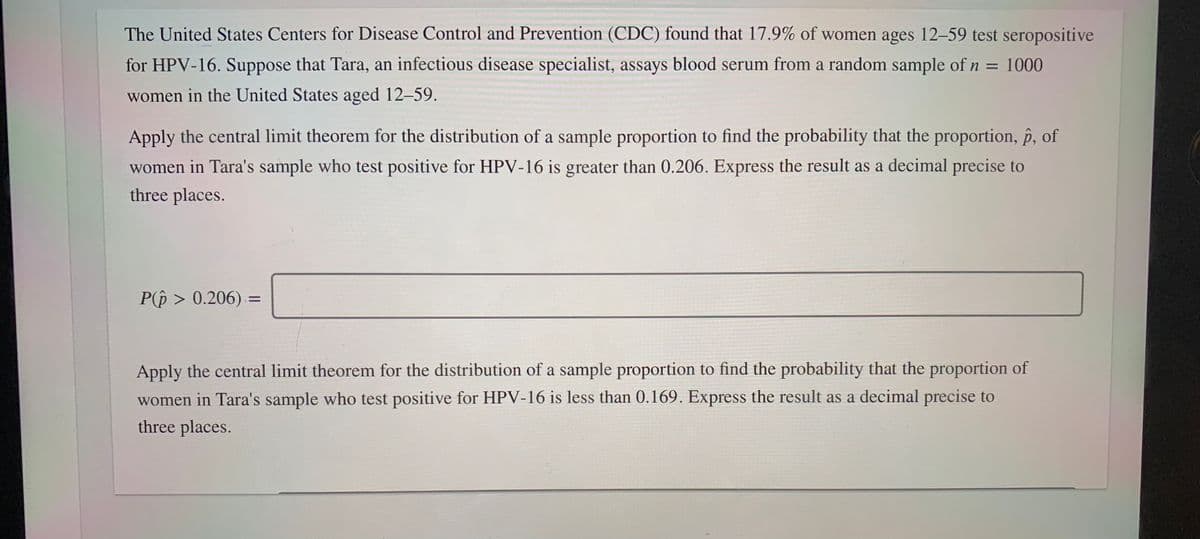The United States Centers for Disease Control and Prevention (CDC) found that 17.9% of women ages 12-59 test seropositive for HPV-16. Suppose that Tara, an infectious disease specialist, assays blood serum from a random sample of n = 1000 women in the United States aged 12-59. Apply the central limit theorem for the distribution of a sample proportion to find the probability that the proportion, p, of women in Tara's sample who test positive for HPV-16 is greater than 0.206. Express the result as a decimal precise to three places. P(p > 0.206) = Apply the central limit theorem for the distribution of a sample proportion to find the probability that the proportion of women in Tara's sample who test positive for HPV-16 is less than 0.169. Express the result as a decimal precise to three places.
The United States Centers for Disease Control and Prevention (CDC) found that 17.9% of women ages 12-59 test seropositive for HPV-16. Suppose that Tara, an infectious disease specialist, assays blood serum from a random sample of n = 1000 women in the United States aged 12-59. Apply the central limit theorem for the distribution of a sample proportion to find the probability that the proportion, p, of women in Tara's sample who test positive for HPV-16 is greater than 0.206. Express the result as a decimal precise to three places. P(p > 0.206) = Apply the central limit theorem for the distribution of a sample proportion to find the probability that the proportion of women in Tara's sample who test positive for HPV-16 is less than 0.169. Express the result as a decimal precise to three places.
Chapter8: Sequences, Series,and Probability
Section8.7: Probability
Problem 11ECP: A manufacturer has determined that a machine averages one faulty unit for every 500 it produces....
Related questions
Question

Transcribed Image Text:The United States Centers for Disease Control and Prevention (CDC) found that 17.9% of women ages 12-59 test seropositive
for HPV-16. Suppose that Tara, an infectious disease specialist, assays blood serum from a random sample ofn = 1000
%3D
women in the United States aged 12-59.
Apply the central limit theorem for the distribution of a sample proportion to find the probability that the proportion, p, of
women in Tara's sample who test positive for HPV-16 is greater than 0.206. Express the result as a decimal precise to
three places.
P(p > 0.206) =
Apply the central limit theorem for the distribution of a sample proportion to find the probability that the proportion of
women in Tara's sample who test positive for HPV-16 is less than 0.169. Express the result as a decimal precise to
three places.
Expert Solution
This question has been solved!
Explore an expertly crafted, step-by-step solution for a thorough understanding of key concepts.
This is a popular solution!
Trending now
This is a popular solution!
Step by step
Solved in 2 steps with 1 images

Knowledge Booster
Learn more about
Need a deep-dive on the concept behind this application? Look no further. Learn more about this topic, statistics and related others by exploring similar questions and additional content below.Recommended textbooks for you


Algebra & Trigonometry with Analytic Geometry
Algebra
ISBN:
9781133382119
Author:
Swokowski
Publisher:
Cengage


Algebra & Trigonometry with Analytic Geometry
Algebra
ISBN:
9781133382119
Author:
Swokowski
Publisher:
Cengage